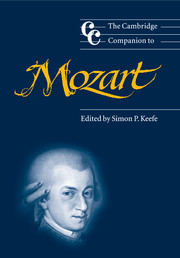16 - Mozart the performer
from Part IV - Performance
Published online by Cambridge University Press: 28 September 2011
Summary
When trying to recreate an image of Mozart as a performer, we must remember that the word ‘performer’ conveys a quite different meaning today from what it would have conveyed in the eighteenth century. A knowledge of the craft of music and outstanding musical abilities made a performer exceptional at that time, rather than an ability to play the most technically complex pieces in the fastest possible tempo, after enormous amounts of practice on an instrument. Like so many other modern thoughts about the art of music, the later conception of the ‘performer’ originated in the first third of the nineteenth century. The Czerny-type of drill and relentless daily practice have brought about a fundamental change in music making.
This is not to say, of course, that Mozart was not a virtuoso performer of the first order. Especially in his last decade, he became the celebrated star of Viennese concert life. He had found the ideal medium for his artistry in the eighteenth-century fortepiano and was, in fact, the first great exponent of that instrument.
Childhood and youth
The versatility of Mozart the Wunderkind was so disconcerting that it would have been impossible during his early years as a performer to predict how his future career would develop. Besides composing, he played not only the harpsichord and the clavichord, but also the organ and the violin; he also sang in public. Although the well-known stories connected with the early travels of the Mozart family often remind us of the productions of entertaining troupes, the unique gifts of Wolfgang shine through right from the outset.
- Type
- Chapter
- Information
- The Cambridge Companion to Mozart , pp. 213 - 226Publisher: Cambridge University PressPrint publication year: 2003



